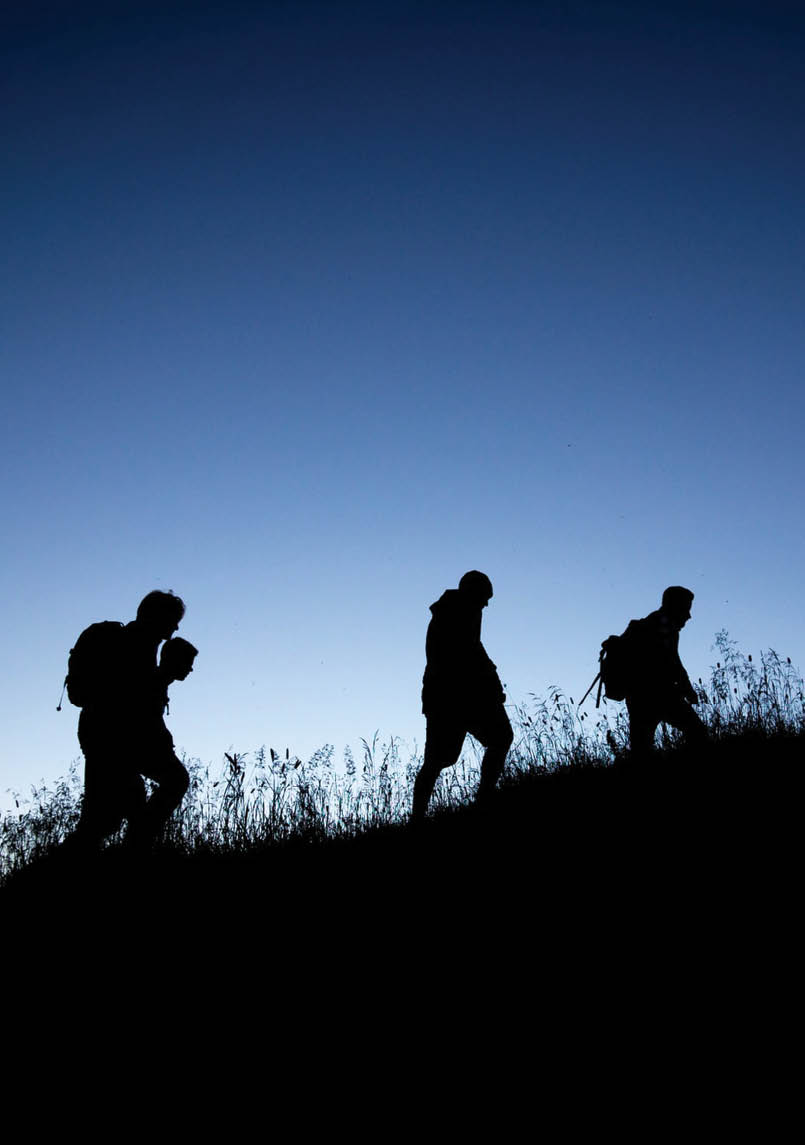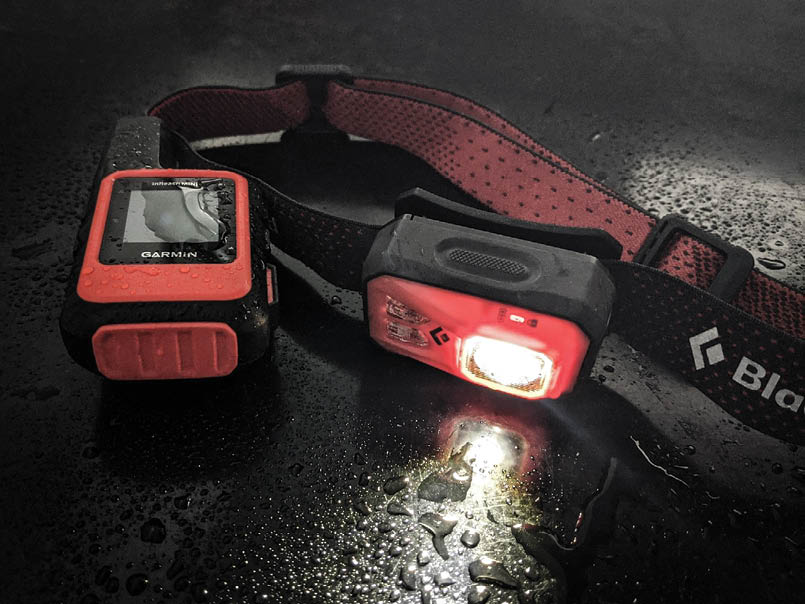

Sometimes by choice, mostly because a walk’s taken longer than planned, bushwalking at night brings new challenges and hazards.
Tobias Mrzyk

Night Walking
Wildwanderer

16 | BWA August 2021


I had an interesting walk the other week. There is a three hour circuit through my local national park which I do once every few months. Previously, all my walks on this trail had been during the day. On this particular Friday, work finished a bit early, so I decided to go night bushwalking.
It has always been a concern of mine when walking in alpine regions that weather and mist can descend quickly. I had encountered it a few times before, most notably on a spring trip in New Zealand. On an alpine trail I was hit with strong wind and cold. The mist descended bringing visibility to about 8 metres.
So, knowing that it would be dark and misty for my Friday walk, I wanted it to be a training walk on navigation and terrain management when visibility is minimal. It was also an opportunity to become more mentally comfortable in these conditions on a relatively safe low-altitude trail.
I was on the trail by 4 pm. Mid-winter temps of 8-10 ºC with a consistent light rain falling, the rainy conditions added an extra and quite enjoyable challenge. As most of the walk is in a narrow river valley, I knew the dark and mist would arrive quickly.
It has been a while since I had bushwalked for a significant distance in the dark. My previous experience had mostly been on Friday night fire trail walks along Narrow Neck in the Blue Mountains to get a head start on a weekend trip in the Wild Dogs.
This trail was quite different to a wide fire trail. During the day it's a clear and easy foot trail through forest, meandering along a river, sometimes rising to negotiate river bluffs. At times the walk moves away from the river to higher in the valley and there is one simple creek crossing to negotiate. (Usually, you don't get your feet wet). The trail is sometimes rocky, sometimes covered in pine needles but mostly it is dirt and was quickly turning to mud in the steady rain.
InReach mini satellite communicator with SOS function and a Black Diamond revolt headlampWildwanderer
BWA August 2021 | 17

I'd packed for the conditions, rain jacket and rain pants, a fleece in my pack, fully charged water resistant head torch and a backup light. I had two GPS, (my new Fenix 6x watch which has maps and the Orux maps nav phone app), a compass, and my Inreach mini with an SOS function in its pouch for emergencies. A first aid kit, emergency blanket, food, water and a waterproof pack liner completed the gear list.
In hindsight, to be extra safe I could have added an emergency fly, 3/4 mat and thermals. I didn't take them but it would have been a good idea. I also knew the direction of the nearest road which was parallel to the trail, it wasn't far away and provided an always there emergency exit point.
I wore a merino top, light nylon bushwalking pants, walking shoes and my hooded rain jacket.
As it turned out I didn't need to put on the rain pants, while my jacket had a lot of water beading on the surface, I was moving quick enough that the combo of body heat and light drizzling rain, kept my bush walking pants just slightly damp. I was more comfortable without the sweat-inducing rain pants on.
I took my walking pole, usually this trail is not steep or rocky enough to require it. In the dark it was valued especially negotiating wet rocks.
As I walked, it approached 5 pm and the shadows lengthened. In some areas with rock overhangs and steep forested banks that rise on the side of the trail it was already quite dim and hard to see my feet. It's this twilight time that can be difficult because depending on the foliage and terrain coverage, one moment you’re in darkness, the next back in light again.
Visibility on trackWildwanderer
18 | BWA August 2021
I made the creek crossing still in twilight, not difficult as the water was low and I remembered the easiest stepping path across the rocks from previous walks. Even in the dark it would have been a simple crossing.
At 5 pm it quickly became dark. It is amazing how the dark envelops the trail, trail side foliage becomes shadows, anything further than 2-3 metres is an inky blackness. Depth perception becomes trickier; in torchlight everything looks flatter than it really is. It became important to slow down and examine any descent for the best way before attempting to walk down even minor rock shelves.
I have a decent head torch and the light usually gives me about 20-25 metres of visibility for five hours. However, in misty and rain conditions these distances go out the window. Even pumping out full brightness I could only see 4-5 metres in front of me. The light gets "caught" by the mist and turns into a haze. The brighter the light the worse this effect seems to be. It's the same when driving at night in heavy mist. I ended up turning the head torch down a bit as full brightness was just wasting battery for no gain in visibility.
Mostly the heavy foliage on either side of the trail became an advantage. It keeps you corralled on the track preventing any accidental divergence.
It became trickier when the track moved into areas of a type of river "pine". (Sorry not that good with the botany ... the trees had pine needles that is all I know). These "pines" were spaced further apart and there was no ground shrubs or grasses only dead pine needles covering the ground. This meant everything for 360 degrees around me was easily mistaken for the track. I had to slow down, be mindful of direction and slope of the land. My memory of the trail became important.
In reality, there wasn't a danger of becoming lost. I had the GPS and even if I'd wandered off the trail, I felt confident I would be able
to make my way back to the river and use that as a means of finding the trail again. In that location the trail is mostly within 10-40 metres of the water. So, moving back to the river, along and then heading perpendicular once out of the "pine" tree area would have found a clear foot trail again even at night.
Still, it was good reminder to use all the tools available:
The compass to confirm the direction of the trail;
Use memory of earlier trips on that trail;
Visually review the slope of land (trails are usually even); and
Use the GPS to ensure I'm not tens of metres away from where I think I am.
I was walking solo and one of the challenges of walking in the dark is mental. It's the unknown that inspires the most fear. And it doesn't get more unknown than inky blackness on a misty night with no moon. It helped a lot that I had to keep focused on navigating and avoiding terrain pitfalls. When your mind is occupied, there is no opportunity for your imagination to conjure up false fears that might be hidden in the night.
I ended up having a great deal of fun. Looking at my GPS track of the route when I got back home, I didn't slow much more than I would have during the day and covered the 10 kilometres in under three hours.
This was a very worthwhile trip in search of something different and a good way to train for more difficult low visibility environments that are less forgiving.
Important noteIt's critical to have the appropriate skills, experience and equipment before attempting a walk such as this. Be conservative, walk on an easy trail, close to civilisation. Be on an extremely familiar trail. Do not walk solo unless you really know what you are doing and are sure how you will react to the dark.
Keep focused, be terrain and location aware, make smart decisions and most importantly keep calm. Tell someone where you're going and when you will be back.
“It is amazing how the dark envelops the trail ...
BWA August 2021 | 19